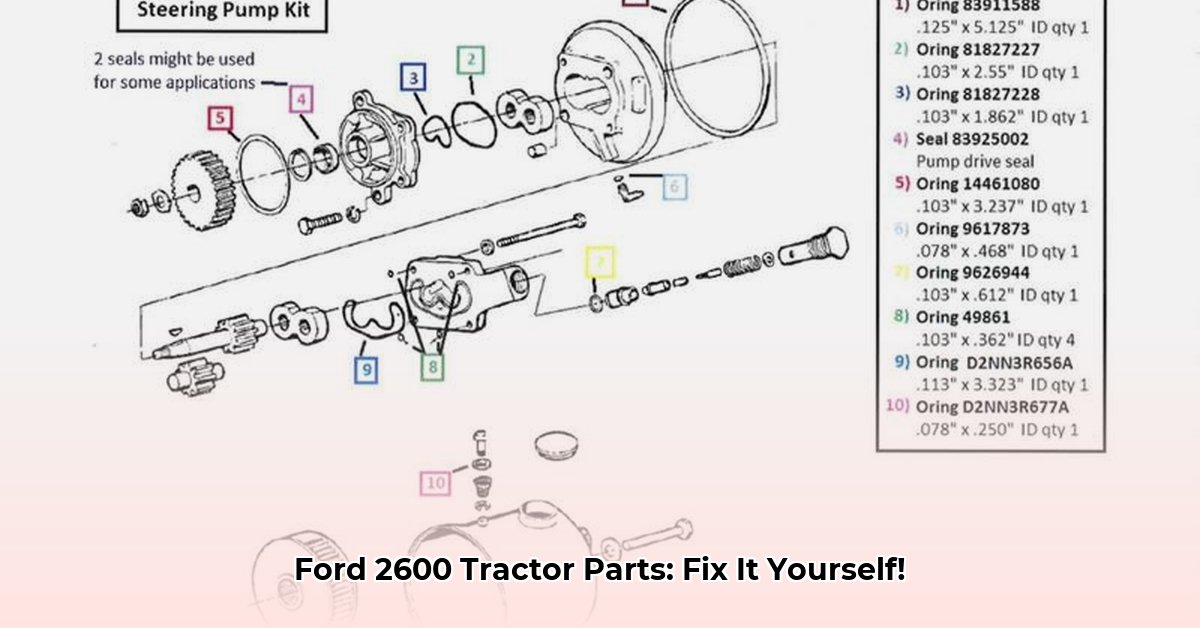
Understanding your Ford 2600 tractor's parts diagrams is the key to successful repairs. This comprehensive guide will equip you with the knowledge and resources to decipher diagrams, locate parts, and troubleshoot common issues, whether you're a seasoned mechanic or a novice home enthusiast. For additional parts diagrams, check out this helpful resource: Ford parts catalog.
Cracking the Code: Reading Your Ford 2600 Parts Diagram
Ford 2600 parts diagrams, often called "exploded views," aren't just random images; they're meticulously organized visual guides. Imagine taking apart your tractor and carefully laying out each piece, numbered and labeled. Each part possesses a unique number – your key to ordering the correct replacement. The diagram illustrates how everything interconnects, revealing the relationships between components. You'll frequently encounter symbols representing fasteners (nuts, bolts, etc.). These are typically straightforward. A high-quality diagram is crucial; a blurry image hinders understanding. Begin with a simpler system, perhaps the carburetor, to grasp the concept. Practice enhances proficiency!
Tracking Down Your Ford 2600 Parts Diagram: A Multi-Pronged Approach
Locating the correct diagram might seem daunting, but it needn't be. Begin your search online. While original Ford documentation can be elusive for older models, many reputable aftermarket suppliers offer downloadable diagrams. Websites specializing in classic tractors are also valuable resources. Be specific when searching; using your tractor's exact model number (“Ford 2600”) yields better results. Online forums dedicated to Ford 2600 owners are treasure troves of knowledge and practical advice; fellow enthusiasts frequently share experiences and diagrams.
Sourcing the Right Parts: Strategies for Success
Once you've identified the faulty part using your diagram, it's time to source a replacement. The aftermarket parts landscape is diverse; quality and pricing fluctuate considerably. Take your time; compare prices across various suppliers and thoroughly read customer reviews. Contact multiple vendors as part availability varies significantly. Remember, finding the part is only part of the battle; securing a high-quality component is paramount. Consider the following strategies:
Smart Strategies for Sourcing Your Parts:
| Strategy | Pros | Cons |
|---|---|---|
| Established Parts Suppliers | High-quality parts; reliable shipping; warranties often included. | More expensive; potentially longer wait times. |
| Online Marketplaces | Wider selection; potentially lower prices; convenient. | Quality can be inconsistent; increased risk of counterfeits/substandards. |
| Tractor Forums/Communities | Access to owner experiences; advice on finding specific parts. | Parts may be used; shipping reliability may be less consistent. |
| Salvage/Used Parts | Cost-effective for some components. | Unknown part history; potential for hidden damage or wear. |
Troubleshooting and Repairs: Using Your Diagram for Diagnosis
Your parts diagram isn't just for ordering; it's an invaluable troubleshooting tool. Let's say your tractor's hydraulic system is malfunctioning. Consult your diagram to trace the hydraulic lines and components. This visual guide helps pinpoint potential issues, like a leaking seal or a faulty pump. Knowing the precise failing part significantly streamlines the repair process. Isn't it remarkable how a simple diagram can save you hours of frustration?
Common Ford 2600 Problems & Diagram-Based Troubleshooting:
- Hydraulic Leaks: Trace hydraulic lines on the diagram, looking for cracks or loose connections. Regular inspections prevent small leaks from escalating.
- Electrical Issues: Wiring diagrams are crucial. Follow the flow of electricity to identify the faulty component.
- Engine Troubles: The engine section of your diagram provides detailed information for identifying problematic components.
- Transmission Problems: If gears are shifting poorly, use the diagram to understand your tractor's transmission's internal workings.
Expanding Your Search: Essential Online and Offline Resources
Locating information on vintage tractors can be challenging, but online communities and dedicated suppliers are invaluable.
- Specialized Tractor Parts Suppliers: These suppliers often possess excellent resources and can locate hard-to-find parts. Do your research and compare prices!
- Online Forums and Communities: Connecting with other Ford 2600 owners provides invaluable insights. They share similar challenges, solutions, and sometimes even parts!
- 3D Printing: For particularly unique situations, 3D printing offers a potential solution to recreate unavailable parts. This requires technical expertise and access to a 3D printer. Is 3D printing a viable option for your specific needs?
Restoring and maintaining a classic tractor requires patience and persistence. With a good parts diagram, you'll be well-equipped to handle most repairs. Good luck, and happy fixing!